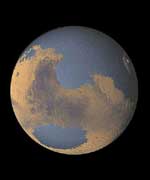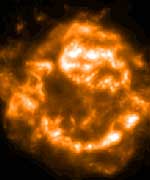
Image credit: NASA
Scientists have long been tantalized by the question of whether life once existed on Mars. Although present conditions on the planet would seem to be inhospitable to life, the data sent back over the past 10 months by NASA’s two exploration rovers, Spirit and Opportunity, showed a world that might once have been warmer and wetter — perhaps friendly enough to support microbial organisms.
Now a Cornell University-led Mars rover science team reports on the historic journey by the rover Opportunity, which is exploring a vast plain, Meridiani Planum, and concludes with this observation: “Liquid water was once present intermittently at the martian surface at Meridiani, and at times it saturated the subsurface. Because liquid water is a key prerequisite for life, we infer that conditions at Meridiani may have been habitable for some period of time in martian history.”
The article is one of 11 published this week (Dec. 3, 2004) in a special issue of the journal Science, authored by scientists connected with the Mars rover mission, several from Cornell and from the Jet Propulsion Laboratory in Pasadena, Calif., the mission’s manager. The issue covers Opportunity through its first 90 days of exploring its landing site of Eagle crater in Meridiani Planum. This was before the rover drove to and entered the large crater dubbed Endurance, from which it is now about to emerge.
Steve Squyres, Cornell professor of astronomy and leader of the rovers’ Athena science team, is the lead author of the main paper, “The Opportunity Rover’s Athena Science Investigation at Meridiani Planum, Mars.” In another paper, on which he is also the lead author, Squyres again refers to the geological record at Meridiani Planum as suggesting that conditions were suitable for “biological activity” for a period of time in the history of mars. In the article, “In Situ Evidence for an Ancient Aqueous Environment at Meridiani Planum, Mars,” he writes: “We cannot determine whether life was present or even possible in the waters at Meridiani, but it is clear that by the time the sedimentary rocks in Eagle crater were deposited, Mars and Earth had already gone down different environmental paths. Sample return of Meridiani rocks might well provide more certainty regarding whether life developed on Mars.”
The Mars rover mission is not designed to look for microbial life but to look for evidence of whether conditions were once right for life. As Squyres recently stated, “What we were seeking was rocks that were actually formed in liquid water so that we could read the record in those rocks, not just to say liquid water was on Mars but to learn something about what the environmental conditions were like, would they have been suitable for life and, importantly, do the minerals that were formed have the capability to preserve for long periods of time evidence of former life? That’s probably the single most important thing we have found: evidence for minerals at Meridiani that are the kinds of things that are very good at preserving evidence of ancient life for very long periods of time.”
Opportunity bounced down on Jan. 25, 22 days after its twin, the rover Spirit, landed on the opposite side of Mars in Gusev crater. Last August Science published a special issue on Spirit.
“This is the first peer-reviewed presentation of the data from Opportunity,” notes Jim Bell, Cornell associate professor of astronomy and the lead scientist for the rovers’ Pancam color imaging system.
Bell also is prominent in the special issue of Science , including his lead authorship of a paper, “Pancam Multispectral Imaging Results from the Opportunity Rover at Meridiani Planum.”
When Opportunity landed on the red planet last January, the robot geologist sent back images of its landing site that were unlike any of the other places where earlier lander probes and rovers had gone. Instead of rusty deserts of dusty soil and boulders strewn to the horizon, Opportunity had landed in a relatively small crater in a vast sea of sand nearly devoid of rocks. Fortunately, an intriguing outcrop of bedrock presented itself nearby, which scientists hoped would be a sample of the original crust underneath the layers of dust.
The scientists were not disappointed. Scattered among the outcrop rocks were large numbers of small, round mineral deposits that the Athena science team named “blueberries.” On Earth, such formations appear when large amounts of water course through rock layers, leaching out the iron-bearing minerals into small spherical rocks and granules. The rovers also detected large amounts of sulfate salt deposits. Enough evidence was collected by Opportunity in the two months it spent examining Eagle crater that the science team felt confident enough to announce in early March that liquid water had flowed over the crater’s rocks long ago, possibly for a long time. Following on this, the latest Science articles largely focus on Opportunity’s most important scientific and geological accomplishment: the discovery of evidence that liquid water once flowed through the region.
Like the coverage given to Spirit in the August issue of Science , the latest edition contains several foldouts with big color panoramas and images from Opportunity’s region of exploration.
Original Source: Cornell News Release



